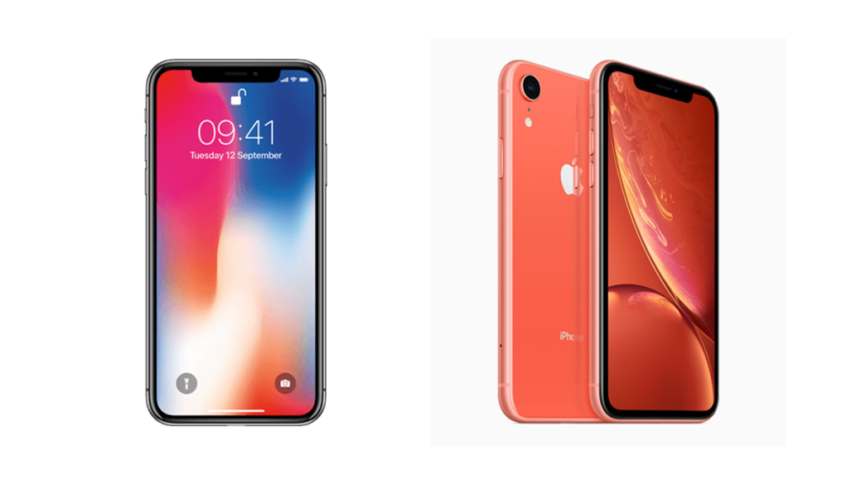The iPhone X and XR represent two landmark models in Apple’s lineup, each marking significant strides in smartphone innovation and design. The iPhone X, launched in 2017, celebrated a decade of iPhones with a design overhaul that set new standards. On the other hand, the iPhone XR released a year later, offered a colorful and more affordable alternative without compromising performance. This comparison aims to dive deep into both models, exploring their nuances and helping users make an informed choice.
Related: iPhone 15 Compared to iPhone 15 Pro
iPhone X vs iPhone XR: Choosing the Right iPhone for You
Trying to decide between the iPhone X and iPhone XR? Both offer a premium Apple experience but with key differences. This guide will help you pick the perfect iPhone for your needs.
Design and Display
| Feature | iPhone X | iPhone XR |
|---|---|---|
| Display Size | 5.8-inch OLED | 6.1-inch LCD (Liquid Retina HD) |
| Resolution | 2436 x 1125 pixels | 1792 x 828 pixels |
| Material | Stainless steel frame, glass front and back | Aluminum frame, glass front and back |
| Home Button | Yes, with Touch ID | No, Face ID unlock |
At first glance, the iPhone X and XR share a similar all-screen design philosophy, but if we delve a little deeper, the distinctions become apparent. The iPhone X boasts a stainless steel frame and a glass back, exuding a premium feel. In contrast, the iPhone XR features an aluminum frame with a glass back, balancing durability and elegance. Color choices are more vibrant and numerous with the XR, catering to a broader audience.
The display is where the contrasts become more pronounced. The iPhone X sports a 5.8-inch Super Retina OLED display, renowned for its deep blacks and high contrast ratios. The iPhone XR opts for a 6.1-inch Liquid Retina LCD display, which, while not as rich as OLED, impresses with its color accuracy and brightness. The choice between OLED and LCD influences not just visual experience but also impacts battery consumption.
Camera
| Feature | iPhone X | iPhone XR |
|---|---|---|
| Rear Camera | Dual-lens 12MP (wide + telephoto) | Single-lens 12MP (wide) |
| Front Camera | 7MP TrueDepth | 7MP TrueDepth |
| Portrait Mode | Yes, with dual-lens bokeh effect | Yes, with software-based depth effect |
On paper, the iPhone X and XR might seem closely matched in-camera capabilities, featuring a 12-megapixel rear camera. However, the iPhone X includes a dual-camera setup, providing telephoto zoom and enhanced portrait mode effects. With a single rear camera, the XR leverages software to achieve portrait mode, demonstrating Apple’s prowess in computational photography.
In real-world use, the differences in camera setups translate to the iPhone X offering more versatility in zoom and low-light photography, thanks to its dual lenses. The iPhone XR, however, holds its own with excellent photo quality and smart HDR, making it a strong contender for those who prioritize straightforward, high-quality shots without the need for optical zoom.
Performance and Battery Life
| Feature | iPhone X | iPhone XR |
|---|---|---|
| Processor | A11 Bionic chip | A12 Bionic chip |
| RAM | 3GB | 3GB |
| Battery Life | Up to 21 hours of talk time | Up to 25 hours of talk time |
Both the iPhone X and XR are powered by Apple’s A-series chips, but the XR benefits from the newer A12 Bionic chip. This translates to better performance and efficiency and supports advanced machine learning tasks and better graphics performance. For the average user, both phones are incredibly fast and capable of handling daily tasks and gaming.
Battery life is a critical factor for many users, and here, the iPhone XR shines with a larger battery and a more efficient processor. It consistently outperforms the iPhone X in longevity, offering several more hours of usage on a single charge. This advantage makes the XR a compelling option for heavy users and travelers.
Software
Both models launched with different versions of iOS but have since received consistent updates from Apple, ensuring they run the latest features and security patches. This commitment to software support extends the lifespan of both devices, making them relevant and secure years after their release.
While most of the software experience is similar, features like Face ID have seen incremental improvements in speed and reliability on the XR, thanks to the newer A12 chip’s enhanced neural engine. However, both phones benefit from the full suite of iOS features, including augmented reality applications, Animoji, and Memoji.
Other Features
| Feature | iPhone X | iPhone XR |
|---|---|---|
| Water Resistance | IP67 | IP68 (slightly deeper water resistance) |
| Storage Options | 64GB or 256GB | 64GB, 128GB, or 256GB |
The iPhone XR offers a slight edge in terms of connectivity, with better LTE band support and dual-SIM options via eSIM. Storage options are comparable, with both models starting at 64GB and going up to 256GB, providing ample space for apps, photos, and media.
Noteworthy is the iPhone XR’s Haptic Touch feature, which substitutes for 3D Touch on the iPhone X and offers a different approach to interacting with the device. Additionally, the XR’s range of colors allows for less pronounced personalization with the iPhone X.
Pros & Cons
iPhone X Pros:
- Superior OLED display
- Dual-lens camera with better zoom and portrait mode
- Sleeker design with stainless steel frame
iPhone X Cons:
- Smaller display size
- Older A11 Bionic chip
- Lower battery life
- No longer sold new (only available refurbished)
iPhone XR Pros:
- A larger, more affordable display
- Newer A12 Bionic chip with slightly better performance
- Superior battery life
- More storage options
- Available new (depending on retailer)
iPhone XR Cons:
- Lower resolution LCD display compared to OLED
- Single-lens rear camera (less zoom and potentially weaker portrait mode)
- Aluminum frame (less premium feel compared to stainless steel)
Which Should You Buy?
- Prioritize display quality and camera: iPhone X
- Value a larger screen, longer battery life, and affordability: iPhone XR
- Need the latest phone with the most storage: iPhone XR (if available new)
Who Should Upgrade?
If you’re using an older iPhone and prioritize display quality, camera performance, or a more premium design, the iPhone X (refurbished) could be a compelling upgrade.
Who Can Stick With the iPhone X?
If you’re happy with your iPhone X and its performance, there’s no urgent need to upgrade unless the battery life has significantly degraded.
Final Thoughts
Both iPhone X and iPhone XR offer a fantastic Apple experience. To make the best choice, consider your priorities—display quality, camera features, battery life, or affordability.
Related: iPhone 15 Compared to iPhone 11
iPhone X vs iPhone XR FAQs
Is the iPhone X or XR newer?
The iPhone XR is newer, released in 2018 compared to the iPhone X in 2017.
Are these phones still supported by Apple?
Yes, both iPhone X and XR are eligible for the latest iOS updates.
Can I buy a new iPhone X?
No, iPhone X is discontinued. You can find refurbished models.
Which phone has a better display?
The iPhone X offers a higher resolution OLED display with richer colors. However, the iPhone XR’s LCD display is larger and more affordable.
Does the iPhone XR have portrait mode?
Yes, both phones have portrait mode. However, the iPhone X’s dual-lens system offers a more natural bokeh effect, while the XR relies on software.
Which phone is faster?
The iPhone XR has a slight edge with its A12 Bionic chip compared to the iPhone X’s A11 Bionic chip. However, the difference is minor for everyday tasks.
Which phone has a longer battery life?
The iPhone XR boasts superior battery life, lasting several hours longer on a single charge than the iPhone X.
Should I upgrade from an older iPhone to the X or XR?
If you prioritize display or camera quality, the X (refurbished) could be a good upgrade. If you value a larger screen, battery life, and affordability, the XR is a better choice (if available new).





